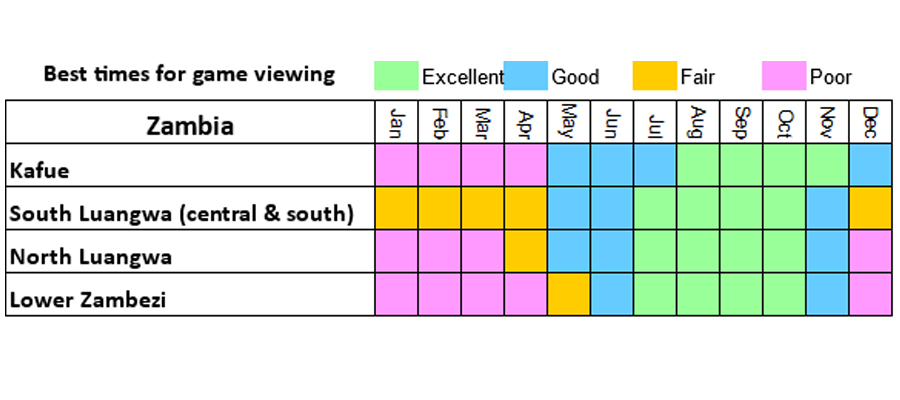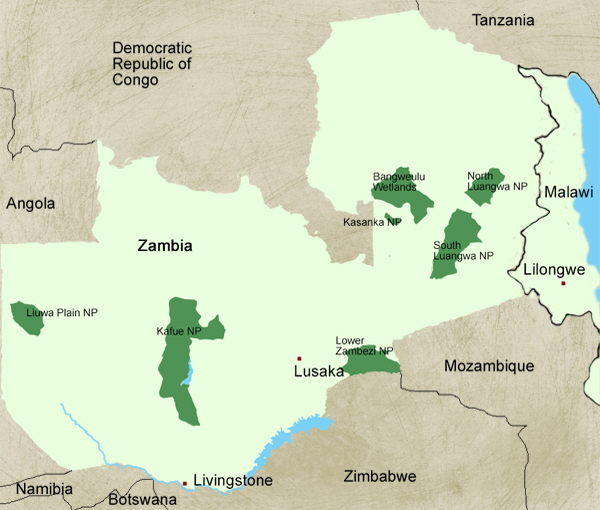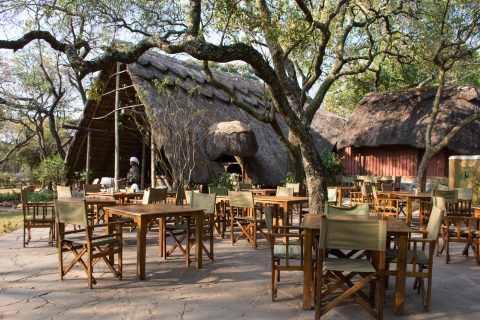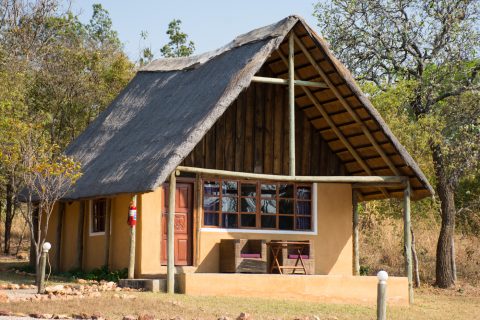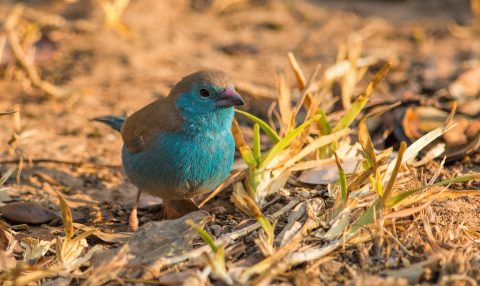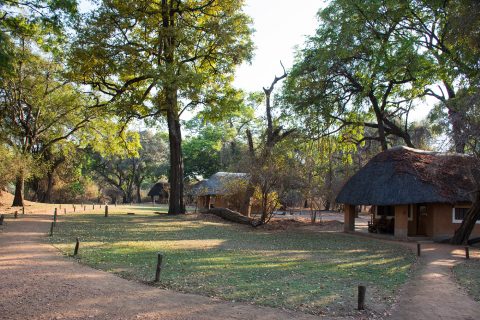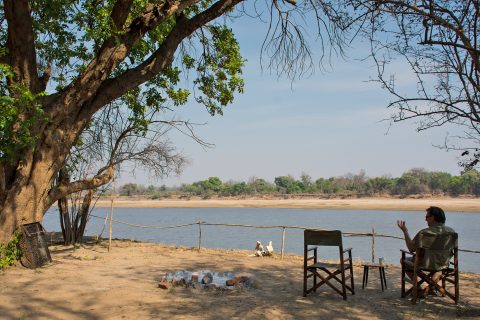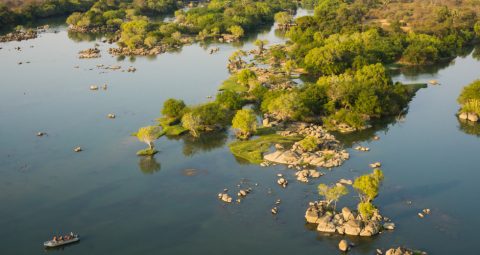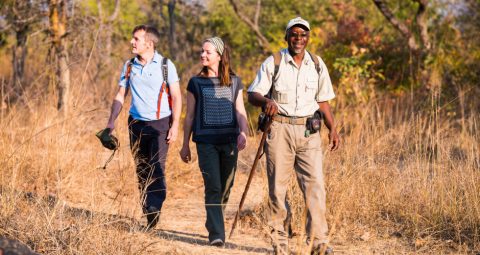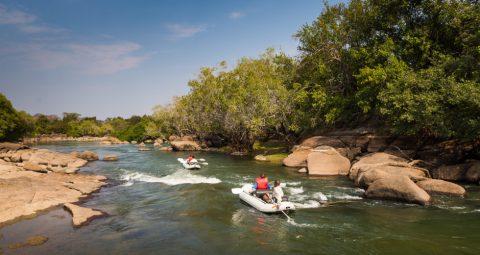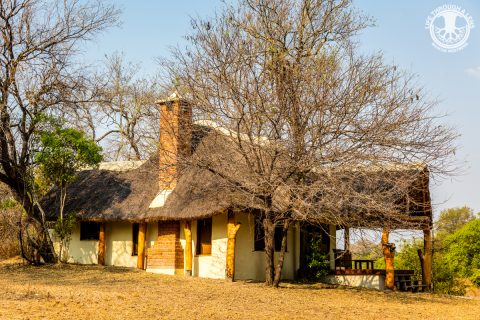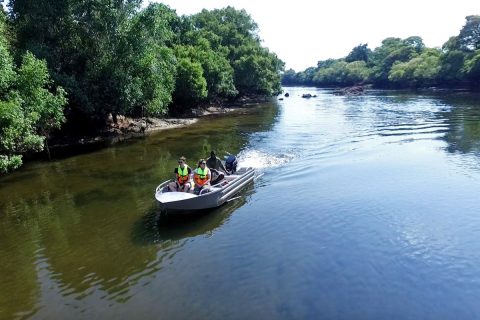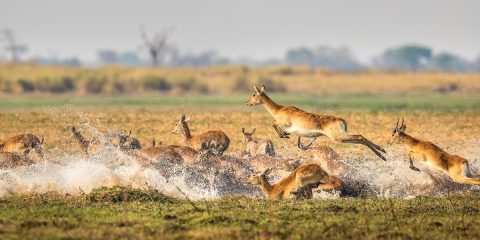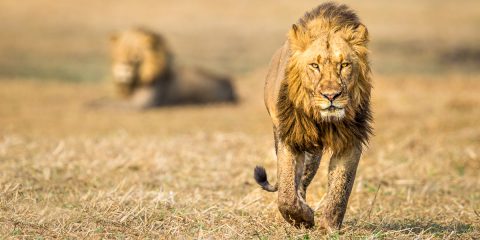Zambia
Zambia lies at the heart of Africa and its National Parks, fed by rivers and wetlands, offer exceptional wildlife viewing. In particular Zambia has established itself as the premier destination in Africa for walking safaris.
The most popular park in Zambia is South Luangwa, renowned for amazing leopard sightings and its herds of elephant and buffalo. As well as having some stunning lodges, the vast Kafue National Park is ideally suited to mobile camping safaris and the Kafue river is fantastic for birding. It’s here that you’ll have the best chance of seeing both roan and sable antelope.
Lower Zambezi National Park combines magnificent game viewing with the chance to canoe on the Zambezi whilst Kasanka National Park is home each year to the World’s greatest bat migration.
Zambia has international airports at Lusaka and Livingstone


Zambia National Parks
Experts regard South Luangwa as one of the greatest wildlife sanctuaries in the world, and not without reason. The concentration of animals around the Luangwa River, and its oxbow lagoons, is among the most intense in Africa.
The Luangwa River is the most intact major river system in Africa and is the life-blood of this 9059 km2 Park. The Park hosts a wide variety of wildlife, birds and vegetation. The now famous ‘walking safari’ originated in this Park and is still one of the finest ways to experience Africa’s pristine wilderness first-hand. The changing seasons add to the Park’s richness, ranging from; dry, bare bushveld in the winter, to a lush, green wonderland in the summer months. There are 60 different animal species and over 400 different bird species in South Luangwa National Park. The most notable exception is the rhino, sadly poached to extinction.
When to Go
Seasonal changes are very pronounced in Luangwa. The dry season begins in April and intensifies through to October, the hottest month, when game concentrations are at their height. Warm sunny days and chilly nights typify the dry winter months of May to August.
The wet season begins in November as the leaves turn green, and the dry bleak terrain becomes a lush jungle. The rainy season lasts up until the end of March and the migrant birds arrive in droves. Each lodge stays open for as long as access is possible, depending on its location in the area.
This remote tract of land, covering 4636 square kilometres, offers one of the finest wilderness experiences in Zambia, if not Africa itself. It is not open to the public and there are no permanent lodges there. Access is with one of the few safari operators granted permission to conduct walking safaris.
The beauty of visiting this Park is the truly remarkable opportunities to experience Africa as it was. It is wild and untouched and you are simply an unobtrusive witness to its natural beauty and drama. Although declared a wilderness area, the North Park, was not open to anyone other than Game Department rangers for more than thirty years. In 1984, Major John Harvey and his wife Lorna sought permission to conduct walking safaris in the area and for many years were the only operators in this remote wilderness.
Then in 1989, two scientists, Mark and Delia Owens, famous for their book ‘Cry of the Kalahari’, were granted permission to set up a research station in the Park. Through their influence and as a means of helping to curb poaching in the area, the authorities allowed entry to a few more safari operators who bring limited numbers into the Park for guided walking safaris and game drives. Their efforts in the North Luangwa are documented in their book ‘Survivors Song / The Eye of the Elephant’.
There are very few roads and you are unlikely to see anyone else for the duration of your trip. Like the South Park, it lies on the western bank of the Luangwa River bordered on the other side by the dramatic Muchinga Escarpment which rises over 1000 meters from the valley floor. Its hazy outline can clearly be seen from the Luangwa River.
There are a number of tributary rivers running through the Park and into the Luangwa which play an important ecological role in the area. The crystal-clear Mwaleshi River trickles down the escarpment in a series of small waterfalls. It recedes in the dry season, leaving many pools along the way, drawing the animals from the bush to its banks in search of water. No game drives are permitted in the Mwaleshi area, and access is by organized walking safaris only.
The vegetation ranges from mopane woodland to riverine forest, open grasslands and acacia thicket. Trees include the beautiful sausage tree, vegetable ivory palms, red mahogany and leadwood.
First established as a National Park in the 1950’s by the legendary Norman Carr, Kafue is one of the largest national parks in the whole of Africa. Despite its size and prominent location only two hours drive from Livingstone, it remains little-known and largely unexplored with vast tracts of its virgin bush still untouched. Thanks to its size and variety of habitat types the Kafue holds a fantastic diversity of wildlife .
What will you see?
The Kafue is not about the sheer numbers of wildlife you see, it is about the diversity of wildlife you see. This is not to say the Kafue does not have healthy populations of many of the more charismatic species of animals, because it does, but if you are looking for the ‘Big 5 in 24 hours’ experience then you will miss the point of this special place. The Kafue is home to more species of ungulate than any national park south of the Congo Basin. Rare and elusive antelope such as the blue and yellow-backed duiker occur in the thickets, sitatunga and lechwe in the swamps, roan, sable and hartebeest in the miombo woodlands, the list goes on.
The park is regarded by those who know it as one of the best places in Africa to find leopard. In certain areas and at certain times of year these secretive and elusive predators are frequently seen, especially on night-drives (allowed in the Kafue) and even from afternoon boat cruises along the Kafue river in the hotter months when leopard come down to drink.
A rarity for Zambia is the cheetah. Cheetah can not be found in the Luangwa or Zambezi national parks and only occur in the west of Zambia, with Liuwa Plains and the Kafue holding the last viable populations of this rare and charismatic predator. In the Kafue cheetah are not solely restricted to the plains, in fact they do very well in mixed woodland and riverine areas, where they can be found preying on puku and impala, amongst others.
Cheetah are found throughout the Kafue, from Nanzhila in the south to the Busanga in the north.
The African wild dog is a highly sought after species for wildlife tourists; these exceptionally rare and elusive predators are not easy to find, however the Kafue has what some might say the largest population of this species compared to any other national park in Africa. Packs can be found on both sides of the Kafue River and in almost all habitat types, from dense woodland to riverine and dambo areas. This species has started to receive much needed and warranted interest in the Kafue from various conservation organizations, as such in 2011 the Zambian Carnivore Programme began baseline studies of wild dog in the Kafue and look set to continue its good work for the foreseeable future.
When to Go
The dry season runs from June to October, with most of the park being inaccessible during the wetter months of November through to April. Inaccessibility however need not be a deterrent to those wanting to visit the Kafue in the ‘green’ season, as it is a spectacular time of year and the lush greenery of the bush is something really to behold. The trick is visiting the camps that do stay open for 12 months (or as close as possible to), Mukambi Lodge, Mayukuyuku and Musekese Camp being some in the central/northern section of the park.
It is possible to reach Itezhi-Tezhi all year round too. The dry season does however enable easier driving and game is generally easier to view in the dryer months.
Temperature-wise the Kafue is wonderfully mild due to it’s altitude, averaging 1100m above sea level; it is generally cooler compared to the Luangwa or Zambezi valley’s in October and November and in fact the Kafue goes sub-zero in winter (June-August) in some areas. The park is well serviced by a number of all-year-round airstrips, notably at Chunga, Ngoma and Lufupa- these enable tourists to make the most of the park in any of it’s ever changing seasons.
Lower Zambezi is still relatively undeveloped, it’s beauty lying in it’s wilderness state. The diversity of animals is not as wide as the other big parks, but the opportunities to get close to game wandering in and out of the Zambezi channels are spectacular. The Park lies opposite the famous Mana Pools Reserve in Zimbabwe, so the whole area on both sides of the Zambezi River is a massive wildlife sanctuary.
The River’s edge is overhung with a thick riverine fringe, including ebony and fig trees. Further inland is a floodplain fringed with mopane forest and interspersed with winterthorn trees and huge acacias. The hills which form the backdrop to the Park are covered in broadleaf woodland.
Even though the Lower Zambezi National Park covers an area of 4092 square kilometers, most of the game is concentrated along the valley floor. There is an escarpment along the northern end which acts as a physical barrier to most of the Park’s animal species. Enormous herds of elephant, some up to 100 strong, are often seen at the river’s edge. ‘Island hopping’ buffalo and waterbuck are common. The Park also hosts good populations of lion and leopard.
When to Go
The best time is mid season from June to September, but all lodges and canoeing operators are open from April to November. Royal Zambezi Lodge and Kayila Lodge is open all year. Fishing is at its best in September / October
What will you see?
The ecological unit of LZNP and the Chiawa Game Management Area support a relatively large population of mammals. The escarpment and plateau regions are largely inaccessible and have not been formally surveyed. A small area on the valley floor is host to many of the bigger mammals, elephant, buffalo, hippo, waterbuck, kudu, zebra, and crocodiles, and occasionally, roan, eland and the Samango monkey. Nocturnal animals here are hyaena, porcupine, civet, genet and honeybadger.
The birdlife along the riverbanks is exceptional. Many a fish eagle can be seen and heard for miles around. Nesting along the cliffs are white-fronted and carmine bee eaters. Other unusual species are the red-winged pratincole, the elegant crested guinea fowl, black eagle, and vast swarms of quelea. In summer the stunning narina trogon makes its home here. Other specialities are the trumpeter hornbill, Meyers parrot and Lilian’s lovebird.
The vegetation in the area is predominated by Acacia albida trees, called the winterthorn, growing 10 to 30 meters high, with the classical shady umbrella canopy. It is able to tolerate sandier soils than other woodland species and serves to stabilize infertile sandbanks and reduce erosion.
Victoria Falls presents a spectacular sight of awe-inspiring beauty and grandeur on the Zambezi River, forming the border between Zambia and Zimbabwe. It was described by the Kololo tribe living in the area in the 1800’s as ‘Mosi-oa-Tunya’ – ‘The Smoke that Thunders’. In more modern terms Victoria Falls is known as the greatest curtain of falling water in the world.
Columns of spray can be seen from miles away as, at the height of the rainy season, more than five hundred million cubic meters of water per minute plummet over the edge, over a width of nearly two kilometers, into a gorge over one hundred meters below.
The wide, basalt cliff over which the falls thunder, transforms the Zambezi from a placid river into a ferocious torrent cutting through a series of dramatic gorges.
Facing the Falls is another sheer wall of basalt, rising to the same height, and capped by mist-soaked rain forest. A path along the edge of the forest provides the visitor prepared to brave the tremendous spray, with an unparalleled series of views of the Falls.
One special vantage point is across the Knife-edge Bridge, where visitors can have the finest view of the Eastern Cataract and the Main Falls as well as the Boiling Pot, where the river turns and heads down the Batoka Gorge. Other vantage points include the Falls Bridge, Devils Pool and the Lookout Tree, both of which command panoramic views across the Main Falls.
This peaceful sanctuary, situated on the south western edge of the Lake Bangweulu basin, is one of Zambia’s smallest national parks. It’s 450 km2 however, are so well endowed with rivers, lakes, wetlands, forests, lagoons, meadows and dambos that it supports a uniquely wide range of animals and abundant birds and fish.
Do not expect to see large herds of animals round every corner, but it is surely one of the most picturesque parks in Zambia with superb birdlife.
About ten years ago Kasanka was in danger of becoming yet another defunct national park due to rampant poaching. David Lloyd, a British expatriate, who had lived in Zambia for many years, visited the Park in 1985 and heard the crack of gunshots. He concluded that if there was still poaching there must still be animals there and set out to save the Park from total depletion. He teamed up with a local farmer, sought funding and along with much of their own resources applied for official permission to rehabilitate the Park. They built tourist camps, roads and bridges and set up the Kasanka Trust to raise funds for this community based project. Slowly it began to earn a little money from tourists to help cover costs. Three years later the National Parks and Wildlife Services Department were sufficiently impressed to sign a 10 year agreement with the Trust allowing full management of the Park in conjunction with National Parks & Wildlife Services and to develop it for tourism in partnership with the local community.
Today, although there is still none of the heart-stopping walking safaris amongst elephant herds, or any lions brushing past your open vehicle as in the larger parks, there are some of the rarest birds and animals in the country, found in the beautiful miombo woodlands, swamp forest, grasslands, floodplains and riverine bushveld, to be enjoyed on leisurely walks and drives. There are ample opportunities for fishing tigerfish, bream and barbel in the beautiful Luwombwa River. Boats are available for hire but you should bring your own tackle.
Recovering from depletion are hippo, sable antelope, and Liechtenstein’s hartebeest. The puku, once reduced to a few hundred, today exceed 1500. There are fairly big herds of the swamp-dwelling sitatunga, reedbuck, waterbuck, Sharpe’s grysbok and the rare blue monkey. Elephants also appear from time to time, and their numbers are expected to recover. Together with Kasanka’s noted birdlife, the animals can be seen on guided walks through the grassy plains, mushitu forests, large tracts of miombo woodland, and alongside riverine forest and papyrus swamps. Over 330 bird species have been recorded, including such rarities as Pel’s fishing owl, the Pygmy goose, Ross’s loerie, the osprey and the wattled crane. If you’re lucky you’ll catch a glimpse of the rare shoebill stork.
When to Go
Kasanka ia open all year round. Birding is especially good in the wet season from November to March when migrants arrive from the north. Game viewing is best in the dry months from May to October.
The incredible bat migration takes place between late October and early November.
This remote park in the far west is pristine wilderness, which, to the ardent bush-lover, is its biggest attraction, and the rewards are great indeed.
The game is spread out across the plains and takes some driving around to find, but to come upon a vast herd of blue wildebeest, a prowling wild dog, or a pride of dozing lions in this forgotten piece of Africa is especially fitting because of its completely natural and uncommercialised state.
The bird life is abundant and the very dramatic storms and lightning rising up on the horizon, contrasting with the green and gold grasslands, create spectacular views and fantastic photographic opportunities.
When to Go
August to December. In November as the rainy season begins, dramatic cloud formations erupt as the storms build, creating spectacular skylines and with the onset of the rains, carpets of flowers explode around the pans. This is also the time when large herds of blue wildebeest migrate across the plains from neighbouring Angola.
Recommended lodges & camps
Pioneer Lodge & Camp – Lusaka
Pioneer Lodge & Camp is an ideal place to stay if you need to be near Lusaka but don’t want to be in it!
Only 14 kms (30 minutes) from the International Airport Pioneer makes a restful stop over before, after or during your Zambian safari.
Accommodation comprises chalets of varying standards, including a family cottage that sleeps up to 6 as well as tented accommodation and a campsite.
The bar and restaurant are friendly and informal and a great place to meet fellow travellers and discuss your safari experiences.
The chalets are set within our 25 acres of miombo woodland and are designed to be in-keeping with your African safari.
There is a relaxed, friendly feel to the whole property. You can safely walk around the grounds or within the local area, which is great for birding too.
Wildlife Camp, South Luangwa
Located just outside the South Luangwa NP, Wildlife Camp is known for its down-to-earth style and consists of rustic chalets, a secluded en-suite tented camp, a bushcamp for overnight walking safaris and a stunning campsite.
Wildlife Camp is divided into three main parts – the Main Camp (consisting of three choices of permanent lodgings), the Bushcamp and the Campsite. Each have their own appeal, with their own unique atmosphere and views of the beautiful surroundings.
KaingU Safari Lodge – Kafue
Set in an area of pristine wilderness, KaingU Safari Lodge offers a magnificent safari experience in the heart of the African bush. The owner-run lodge, with its comfortable accommodation perfectly in balance with the surroundings, is something unexpected in this remote area. The lodge was built with a lot of patience, good taste and an extraordinary sense for detail.
Set on raised individual private wooden decks, each overlooking the Kafue River, KaingU Safari Lodge comprises 6 double Meru-style tents with en-suite bathrooms, indoor showers and an open-air shower. The “Honeymoon-tent” has an additional outside bath. Every tent is additionally roofed with thatch to provide additional cooling and further blend into nature.
As well as game drives into the renowned Kafue NP, one of the highlights at KaingU is taking a boat trip on the river, whether for game viewing or just for a picnic.
Kafue River Lodge
Kafue River Lodge is the reward at the end of your journey into the North-Eastern Kafue. Located on a wonderfully secluded stretch of the Kafue River, the 4 en-suite chalets overlook the river and the sounds of hippo carry clearly across the grounds with the miombo woodland behind camp also playing home to a steady stream of game and birds.
With just 4 en-suite chalets Kafue River Lodge is delightfully intimate. There are 2 central areas – an open, riverside “fire pit” for starlit dining and early morning coffee and the beautiful main lapa area which is built on a deck over the river offering cool shade and 180 degree river views.
Kasonso Busanga Camp
The Busanga Plains is undoubtedly the best place for wildlife viewing in Kafue National Park and Kasonso is located right in the heart of the prime game viewing area.
Kasonso Camp is a simple bush camp. Each tent has an en-suite bathroom with a shower, sink and toilet.
You can explore the Busanga Plains by morning, afternoon or all day game drives with your specialist Busanga guide. Busanga Plains is renowned for large numbers of red lechwe, but is also well known for the big lions, buffalo, elephant, wildebeest and roan antelope.


